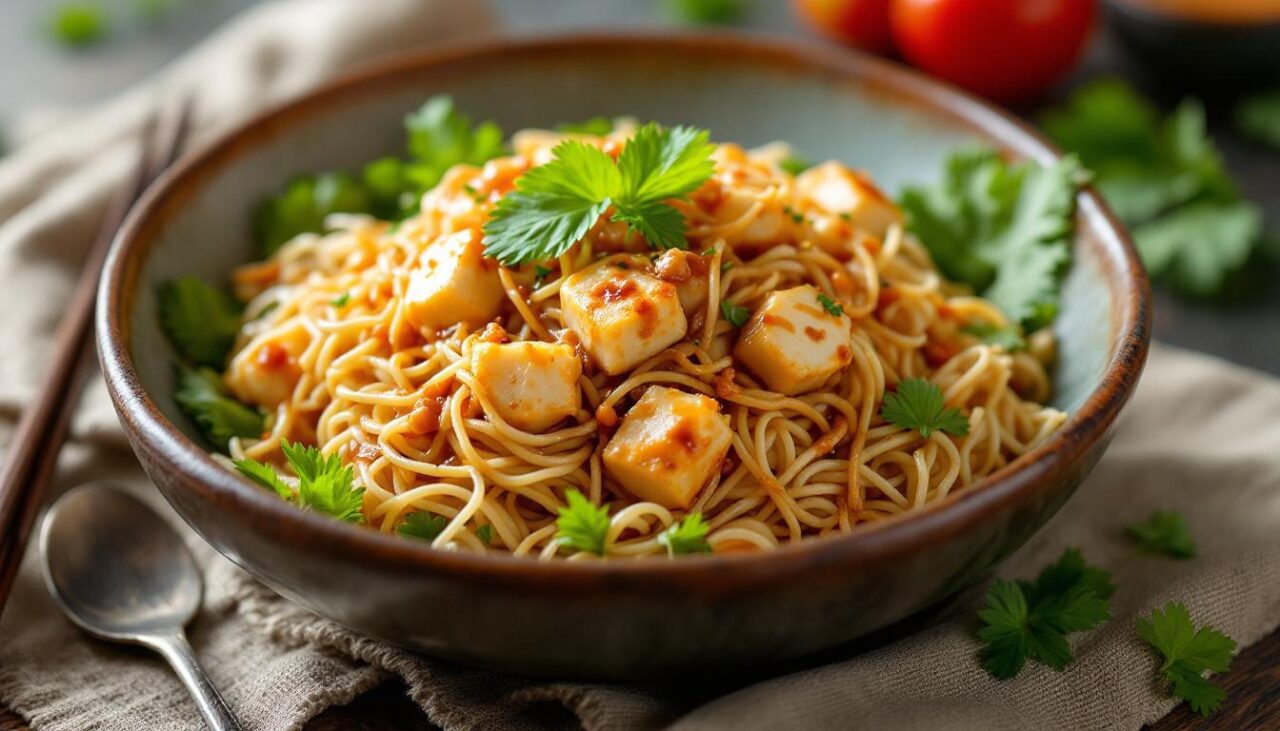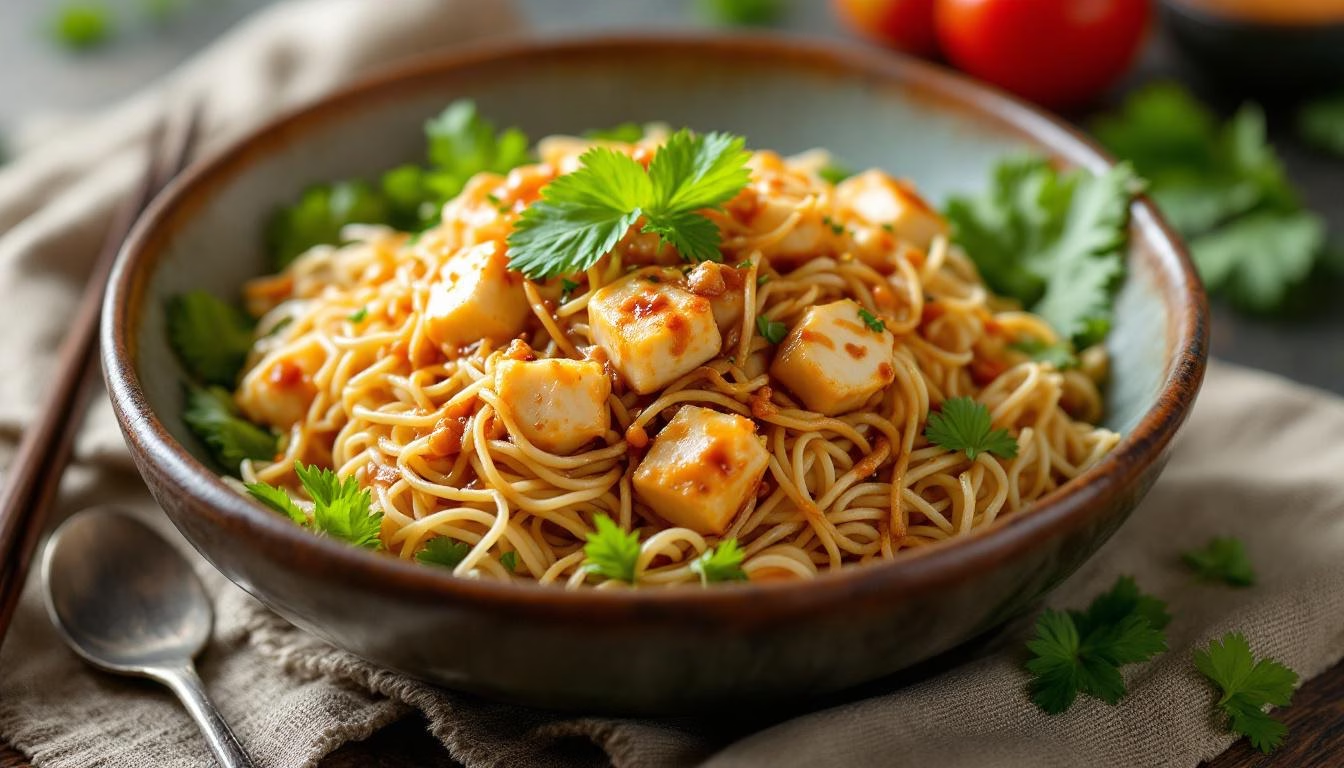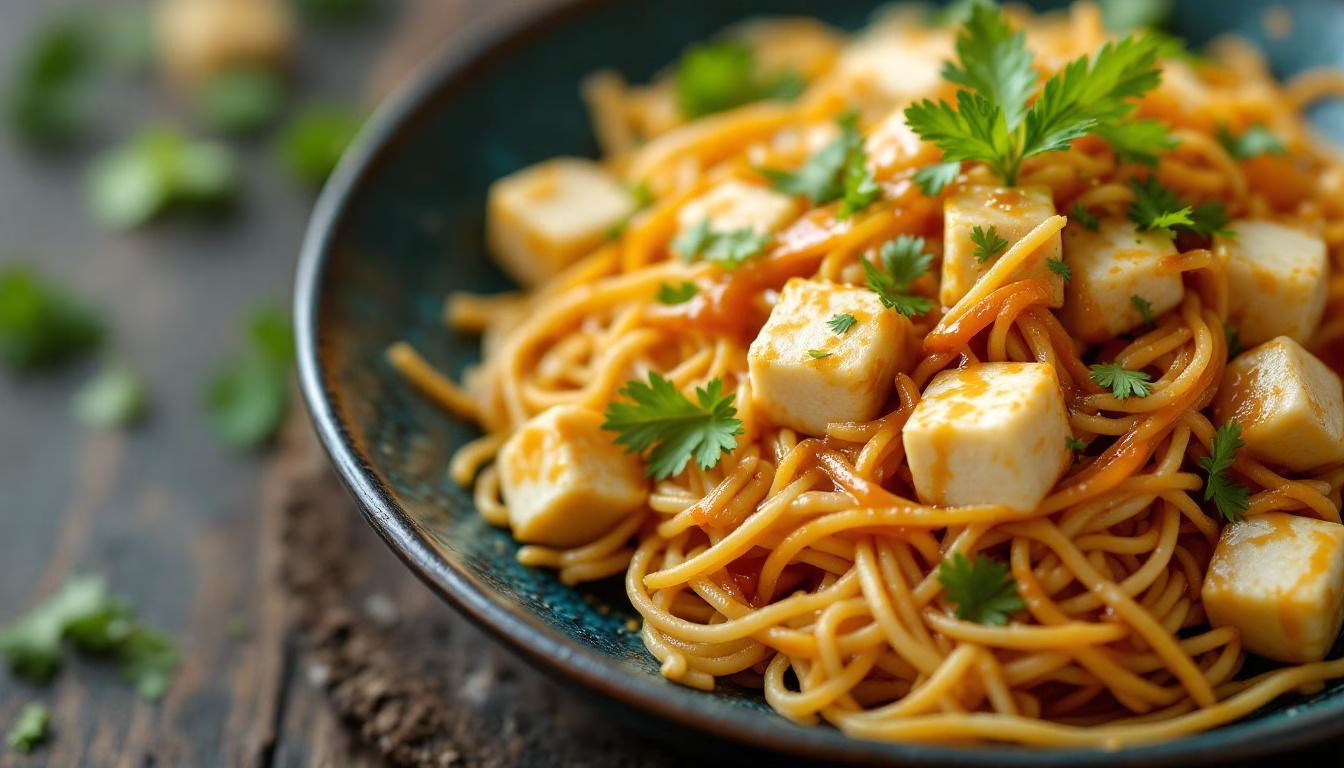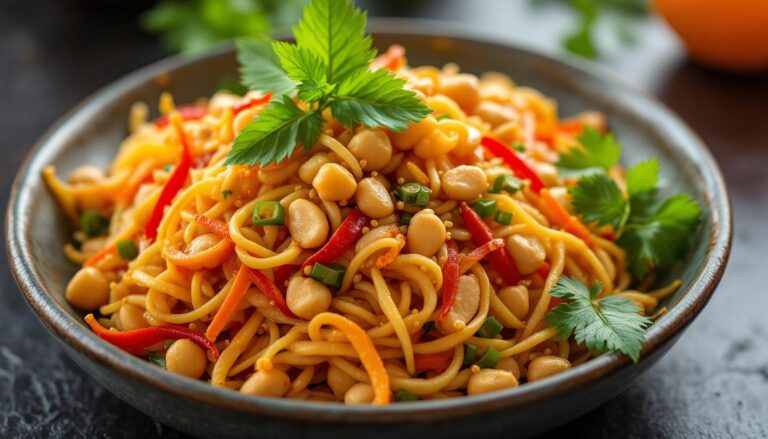Indonesian Ketoprak Recipe
Authentic Indonesian Ketoprak Recipe with Peanut Sauce – I’ll never forget the first time I encountered ketoprak on a bustling Jakarta street corner, watching the vendor’s practiced hands layer components with the precision of a symphony conductor.

Indonesian Ketoprak - Tofu Salad
Ingredients
- 5 tablespoons smooth peanut butter
- 1 scallion (chopped)
- 4 Bird's eye chilies
- 2 cloves Garlic.
- 2 tablespoons coconut sugar (or brown sugar)
- 2 tablespoons calamansi juice or Lime juice.
- ¼ cup. kecap manis (Indonesian Sweet soy sauce)
- ¾ cups water
- 3 tablespoons canola (vegetable or peanut oil)
- 7 oz. / 200 grams (Half of a block extra-firm tofu)
- 1 cup Bean sprouts
- 10.5 oz./ 300 grams. cooked Lontong
- 50 gr. rice vermicelli (soaked in warm water for 10 minutes)
- 6 tablespoons dry roasted peanuts
- Birds Eye chilies
- Cilantro leaves
- Minced scallions
- Cucumbers
Instructions
- In a blender or food processor, blend the peanut butter, chilies, garlic, coconut sugar, calamansi (or lime juice), kecap manis, and water until smooth and thick.
- Cut the tofu, then shallow-fry for about 8 minutes until the outer skin is golden; set aside.
- Slice the lontong into bite-size pieces.
- For three servings, place 1/3 of the drained vermicelli in the center of each plate. Add 1/3 cup bean sprouts, 1/3 of the fried tofu pieces, 3-4 slices of lontong, and 2 tablespoons chopped dry roasted peanuts to each portion.
- Generously drizzle each serving with peanut sauce, then optionally garnish with fresh sliced Bird’s Eye chilies, cilantro, minced scallions, and cucumber.
Nutrition
There I was, jet-lagged and slightly overwhelmed by the sensory explosion that is Indonesian street food, when this unassuming cart caught my attention.
The vendor was assembling what looked like the most beautiful, chaotic salad I’d ever seen – golden cubes of fried tofu nestled against translucent rice vermicelli, crisp bean sprouts adding texture, and thick slices of what I later learned was lontong (compressed rice cake) providing substance.
But the real magic happened when he ladled that glossy, mahogany-colored peanut sauce over everything, transforming individual ingredients into something that made my mouth water just watching.
What struck me most wasn’t just how delicious it looked, but how the vendor treated each plate like a small work of art.
He’d arrange the components thoughtfully, drizzle the sauce with a flourish, then top everything with a sprinkle of crushed peanuts and fresh herbs.
It was street food elevated to something almost ceremonial, and when I finally tasted it?
Well, let’s just say I understood why there was always a line at his cart.
The combination of textures – creamy, crunchy, chewy, soft – paired with that complex peanut sauce that managed to be sweet, savory, spicy, and tangy all at once, was nothing short of revelatory.
I knew I had to learn how to make this at home, though it took me several attempts (and a few less-than-stellar peanut sauces) to get it right.
Indonesian Traditional Ketoprak Recipe – Tofu Vermicelli Salad
Ketoprak represents everything I love about Indonesian cuisine – it’s humble yet sophisticated, simple in concept but complex in execution.
This beloved street food originated in Jakarta and has become a staple across Indonesia, with each region adding its own subtle variations.
The name itself comes from the Javanese words “keto” (meaning to cut or chop) and “prak” (an onomatopoeia for the sound of crushing), which perfectly describes both the preparation method and the satisfying crunch you get with each bite.
What makes the best Ketoprak (Indonesian tofu and vermicelli salad with peanut dressing) recipe so special is its brilliant balance of textures and flavors.
Unlike Western salads that often rely on lettuce as a base, ketoprak builds its foundation on rice vermicelli and lontong, creating a more substantial, meal-worthy dish.
The fried tofu provides protein and a satisfying chewiness, while bean sprouts add that essential crunch.
But the real star is that peanut dressing – a complex sauce that combines the richness of peanut butter with the heat of chilies, the sweetness of coconut sugar, the umami depth of kecap manis (sweet soy sauce), and the bright acidity of calamansi or lime juice.
Essential Ingredients for Authentic Ketoprak
Creating the best Ketoprak (Indonesian tofu and vermicelli salad with peanut dressing) recipe starts with understanding your ingredients, and trust me, each one plays a crucial role in the final dish.
Let me walk you through what you’ll need and why each component matters.
The Peanut Sauce Foundation
The heart of any great ketoprak is its peanut sauce, and I’ve learned through trial and error that using smooth peanut butter as your base saves time without sacrificing authenticity.
You’ll need 5 tablespoons of good-quality smooth peanut butter – I prefer natural varieties without added sugar since we’ll be controlling the sweetness ourselves.
The chilies are non-negotiable; bird’s eye chilies provide that signature Indonesian heat, though you can adjust the quantity based on your spice tolerance.
Fresh garlic adds pungency, while coconut sugar (or brown sugar as a substitute) brings a deeper, more complex sweetness than regular white sugar.
Calamansi juice is traditional and provides a unique citrusy tang, but lime juice works beautifully as a substitute – just use it sparingly since lime can be more acidic.
The kecap manis is absolutely essential; this Indonesian sweet soy sauce adds both saltiness and a molasses-like sweetness that you simply can’t replicate with regular soy sauce.
The Salad Components
For the tofu, extra-firm is your best friend here.
I use about 7 ounces (200 grams), which is roughly half a standard block.
The key is getting that golden, slightly crispy exterior while maintaining a tender interior.
Rice vermicelli should be soaked in warm water for about 10 minutes until tender but still with a slight bite – oversoaked vermicelli becomes mushy and disappointing.
Lontong might be the trickiest ingredient to source outside of Indonesia, but it’s worth seeking out at Asian grocery stores.
These compressed rice cakes add a unique chewy texture that’s integral to authentic ketoprak.
If you absolutely can’t find it, you can substitute with firm rice cakes or even extra-firm tofu, though the texture will be different.
Step-by-Step Instructions for Perfect Ketoprak
Making the best Ketoprak (Indonesian tofu and vermicelli salad with peanut dressing) recipe is all about timing and technique.
I’ve broken this down into manageable steps that’ll have you assembling beautiful bowls like a pro.
Preparing the Peanut Sauce
Start with your peanut sauce because it can sit while you prepare everything else, and the flavors actually improve with a little resting time.
In your blender or food processor, combine the peanut butter, bird’s eye chilies, garlic cloves, coconut sugar, calamansi or lime juice, kecap manis, and water.
Blend until completely smooth and thick – this usually takes about 1-2 minutes in a good blender.
The consistency should coat the back of a spoon but still be pourable.
If it’s too thick, add water a tablespoon at a time; if it’s too thin, add a bit more peanut butter.
Taste and adjust – you want a balance of sweet, salty, spicy, and tangy that makes your taste buds do a little happy dance.
Frying the Tofu to Golden Perfection
Cut your tofu into bite-sized cubes, roughly 1-inch pieces.
Pat them dry with paper towels – this step is crucial for achieving that golden exterior.
Heat 3 tablespoons of neutral oil (canola, vegetable, or peanut oil work well) in a large skillet over medium-high heat.
When the oil shimmers, carefully add the tofu pieces, making sure not to overcrowd the pan.
Let them fry undisturbed for about 2-3 minutes per side until golden brown.
The total cooking time should be around 8 minutes, turning the pieces to ensure even browning.
Remove to a paper towel-lined plate and set aside.
Assembly: The Art of Plating
This is where ketoprak becomes almost meditative.
For each serving, start by placing about one-third of the drained vermicelli in the center of your plate or bowl.
Arrange about 1/3 cup of fresh bean sprouts alongside the noodles, then add your golden tofu pieces and 3-4 slices of lontong.
Generously drizzle each serving with the peanut sauce – don’t be shy here, the sauce is what ties everything together.
Sprinkle 2 tablespoons of chopped dry roasted peanuts over each portion for that essential crunch.
Pro Tips and Troubleshooting
After making countless batches of the best Ketoprak (Indonesian tofu and vermicelli salad with peanut dressing) recipe, I’ve learned a few tricks that make all the difference.
Sauce Consistency Secrets
If your peanut sauce breaks or looks grainy, don’t panic!
This usually happens when the oil separates.
Simply add a tablespoon of warm water and blend again – the emulsion should come back together.
For storage, the sauce keeps in the refrigerator for up to a week, though you’ll need to thin it with a little water when reheating since it thickens when cold.
Tofu Frying Mastery
The secret to perfectly fried tofu is patience and the right temperature.
If your oil isn’t hot enough, the tofu will absorb too much oil and become greasy.
If it’s too hot, the outside burns before the inside warms through.
Test with a small piece first – it should sizzle immediately when it hits the oil.
Make-Ahead Strategies
While ketoprak is best assembled fresh, you can prep components ahead.
The peanut sauce improves overnight, fried tofu can be made a day ahead and reheated, and vermicelli can be soaked and drained up to 4 hours in advance (just toss with a tiny bit of oil to prevent sticking).
Creative Variations and Substitutions
The beauty of the best Ketoprak (Indonesian tofu and vermicelli salad with peanut dressing) recipe lies in its adaptability.
Here are some variations I’ve enjoyed experimenting with.
Protein Variations
While tofu is traditional, I’ve successfully made ketoprak with crispy tempeh, grilled chicken, or even hard-boiled eggs.
Each brings its own character to the dish while maintaining the essential Indonesian flavors.
Vegetable Additions
Fresh cucumber adds cooling crunch, blanched spinach or watercress brings color and nutrition, and thinly sliced cabbage provides extra texture.
Some regions add boiled potatoes, which sounds unusual but works surprisingly well.
Spice Level Adjustments
For those sensitive to heat, start with just one bird’s eye chili and taste the sauce before adding more.
Conversely, spice lovers can add extra chilies or include some of the seeds for more heat.
Fresh sliced chilies as garnish let diners control their own spice level.
Sauce Variations
Some cooks add a touch of tamarind paste for extra tanginess, while others include a small piece of palm sugar for more complex sweetness.
A pinch of ground coriander or a small piece of fresh ginger can add interesting flavor dimensions.
What to Expect: Your Ketoprak Journey
Making the best Ketoprak (Indonesian tofu and vermicelli salad with peanut dressing) recipe for the first time is an adventure, and I want to set realistic expectations.
Your first attempt might not look exactly like the photo – mine certainly didn’t!
The sauce might be a bit thicker or thinner than ideal, or you might go heavy-handed with the chilies (been there, done that, cried a little).
What you will get, even on your first try, is a incredibly satisfying meal that showcases the brilliant complexity of Indonesian flavors.
The combination of textures – from the chewy lontong to the crispy peanuts to the silky vermicelli – creates a eating experience that’s both comforting and exciting.
Each bite delivers different flavor notes as the sweet, spicy, tangy sauce mingles with the various components.
Don’t be discouraged if your plating isn’t Instagram-perfect right away.
Ketoprak is street food at heart, meant to be hearty and satisfying rather than precious.
Focus on getting the flavors right, and the presentation skills will come with practice.
Most importantly, taste as you go and adjust the sauce to your preferences – the best ketoprak is the one that makes you happy.
Ingredients:- 5 tablespoons smooth peanut butter- 1 scallion (chopped)- 4 Bird’s eye chilies- 2 cloves garlic- 2 tablespoons coconut sugar (or brown sugar)- 2 tablespoons calamansi juice or lime juice- ¼ cup kecap manis (Indonesian sweet soy sauce)- ¾ cups water- 3 tablespoons canola oil (vegetable or peanut oil)- 7 oz./200 grams extra-firm tofu (half block)- 1 cup bean sprouts- 10.5 oz./300 grams cooked lontong- 50 gr.
rice vermicelli (soaked in warm water for 10 minutes)- 6 tablespoons dry roasted peanuts- Bird’s eye chilies (for garnish)- Cilantro leaves (for garnish)- Minced scallions (for garnish)- Cucumbers (for garnish)
Ketoprak Cooking Instructions:
- Blend peanut sauce ingredients: In a blender or food processor, blend the peanut butter, chilies, garlic, coconut sugar, calamansi (or lime juice), kecap manis, and water until smooth and thick.
- Cut and shallow-fry tofu: Cut the tofu into bite-sized pieces, then shallow-fry for about 8 minutes until the outer skin is golden; set aside.
- Slice lontong: Slice the lontong into bite-size pieces.
- Plate three servings: For three servings, place 1/3 of the drained vermicelli in the center of each plate.
Add 1/3 cup bean sprouts, 1/3 of the fried tofu pieces, 3-4 slices of lontong, and 2 tablespoons chopped dry roasted peanuts to each portion.
- Drizzle with sauce and garnish: Generously drizzle each serving with peanut sauce, then optionally garnish with fresh sliced bird’s eye chilies, cilantro, minced scallions, and cucumber.
- Prep Time: 9 minutes
- Cook Time: 8 minutes
- Total Time: 17 minutes
- Servings: 3
- Calories: 637 kcal per serving








